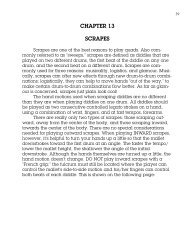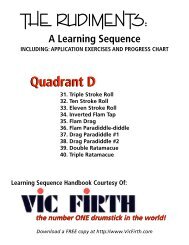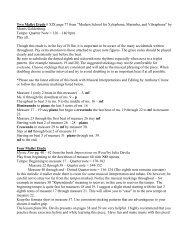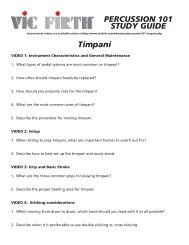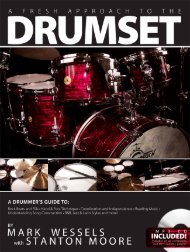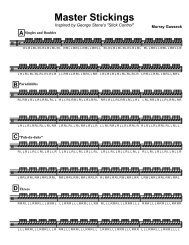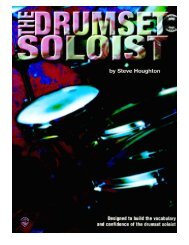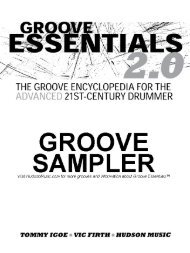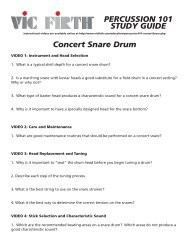BY: MARK WESSELS - Vic Firth
BY: MARK WESSELS - Vic Firth
BY: MARK WESSELS - Vic Firth
You also want an ePaper? Increase the reach of your titles
YUMPU automatically turns print PDFs into web optimized ePapers that Google loves.
Astronomy 104: Homework Set 2Due: Wednesday, February 6, 2013Coverage: Destinations 4, 5, 61. Imagine that the Earth is replaced by a star with a mass of 2.2 M ⊙ . The Sun is still presentand still has a mass of 1 M ⊙ . We’ll ignore all the other objects in the Solar System.Let’s call the new star B and the original Sun star A.a) What is the value of a A and a B in this new binary star system assuming that separationof the stars is 1 AU ?b) What is the orbital period of this binary?2. A typical molecule requires about 0.5 eV (=electron volt) of energy to stimulate any of itsmany excited states. Knowing that 1 eV equals 1.6 × 10 −12 ergs, what part of the electromagneticspectrum would you expect to see the radiation from such molecules? Individualatoms typically require about 5 eV to stimulate their excited states. What kind of electromagneticradiation would you expect to see from typical atoms? Finally, typical transitionsin atomic nuclei require 500 keV (that’s kilo-eV) or higher. What sort of radiation dothese transitions produce? HINT: You only need to carry out one calculation for this problem.After that, you might want to refer to Figure 5.6—and work out how to read it—toavoid having to do any additional significant calculations.3. You tell the police officer that you ran the red light because you were going so fast that itappeared green! Use the Doppler equation to determine how fast you had to be movingfor this to occur. Since this was a 10,000 km/s zone, were you guilty of speeding?4. Let’s explore the idea that stars form from the collapse of gas from the Interstellar Medium.a) How big would the Sun’s radius be if its matter were spread out into a volume sothat its mean density becomes that of the ISM, 1 particle per cubic cm? Feel free toassume the Sun is composed only of H atoms.
SyncopationMusic Theory14In modern dance music, notes on the weak beats (2 & 4, or the “upbeat”) are oftenemphasized (or accented) for effect. These syncopated rhythms are especiallypresent in jazz music. Write the counts under the notes in these two lines, thensee if you can clap while you count out loud to a metronome. Try not to “swing”the rhythm until you can perform it “straight” PERFECTLY!1 2 345➅Music Reading48Keyboard BoogieNot only does this next song have several syncopated rhythms, but it also has a few accidentalsthrown in for good measure. Watch your key signature, and remember the rule: an accidentalreturns to the key signature note when you pass the bar line!Wessels49 ReveilleTraditionalNow that you are used to reading a few sharps, try this one on for size! Don’t memorize – keep your eyes on the music!30
Dynamic Markings and Musical Terms — memorize each of these musical terms.Music Theory: FORTE : loud: MEZZO FORTE : medium loud: PIANO : softcresc : CRESCENDO : gradually get louderaccel : ACCELERANDO : gradually get fasterMusic ReadingThe short “Russian Dance” starts slow and soft, and gradually builds to an exciting finish by usingthe crescendo and accelerando. Watch the dynamics and accents very carefully!50Russian Sailor’s DanceReinhold Gliere— 1st X— 2nd Xgradual cresc. and accelerando to the end51Turkey in the StrawTraditional31
Appendix: Lesson FourteenSpeed Test #1: Write the names of the notes blank provided. Check the key signature before you begin!Speed Test #2: These lines are written in BASS CLEF. You know the routine.1. 2. 3.4. 5. 6.Music Reading Exercise: Try to see each “pattern” in this exercise – read each pattern instead of individual notes!Speed Test #3: This line is difficult because it includes several SHARPS (but no flats). Practice with a metronome to keep asteady tempo. As you get better at finding the notes on the keyboard, speed the tempo of the metronome up5 - 10 beats a minute.58



